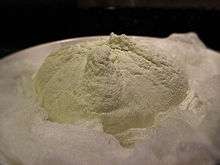Queso blanco

Queso blanco (Spanish pronunciation: [ˈkeso ˈβlaŋko]), along with other similar cheeses including queso fresco (pronounced: [ˈkeso ˈfɾesko]), is a creamy, soft, and mild unaged white cheese, commonly used in the Iberian Peninsula, several Latin American countries including Mexico, and many parts of the United States. The name queso blanco is Spanish for "white cheese", but similar cheeses are used and known throughout the world by different names. Also, it is used to make cheesecake in some parts of the world, such as the United States and France.
It is sometimes made by pressing the whey from cottage cheese, but more often it is made by heating whole fresh milk to near-boiling, adding an acidifying agent such as vinegar, stirring until curds form, then draining the curds in cheesecloth for three to five hours.[1] If it is pressed, and more water is removed, it becomes known as queso seco. It is similar to (if slightly more acidic than) pot cheese and farmer cheese. It has also been compared to quark (or tvorog) from Central and Eastern Europe and to Indian paneer, and is considered one of the easier cheeses to make, as it requires no careful handling and does not call for rennet or a bacterial culture.[1]
Queso blanco is traditionally made from cow's milk, whereas queso fresco may be made from a combination of cow's and goat's milk. They may both be eaten straight or mixed in with various dishes. Some versions of these cheeses, such as Queso Oaxaca, melt well when heated, but most only soften.[2] They are also known as "bag cheeses", as the curds are normally hung in a bag of cheesecloth to drain.[1]
Queso blanco and queso fresco make a creamy addition to recipes, and are often used as a topping for spicy Mexican dishes such as enchiladas and empanadas, or crumbled over soups or salads. Meltable versions are used to make quesadillas.[2] Many Mexican home cooks make their own instead of purchasing it; when made for the evening meal, it is often prepared in early afternoon and left to drain until evening.[1] As it is highly perishable, it must be refrigerated or used immediately once the whey has drained out.
In Peruvian cuisine, several recipes mix queso fresco and spices to make a spicy cold sauce eaten over peeled boiled potatoes, such as papa a la Huancaína or ocopa.
Queso blanco and queso fresco also exist in Brazil and Portugal, and are respectively known as queijo branco (Portuguese pronunciation: [ˈkejʒu ˈbɾɐ̃ku]) and queijo fresco ([ˈkeijʒu ˈfɾeʃku]).
A melted cheese appetizer using white American cheese is sometimes called "queso blanco dip" but the name is merely descriptive. It does not include queso blanco cheese.